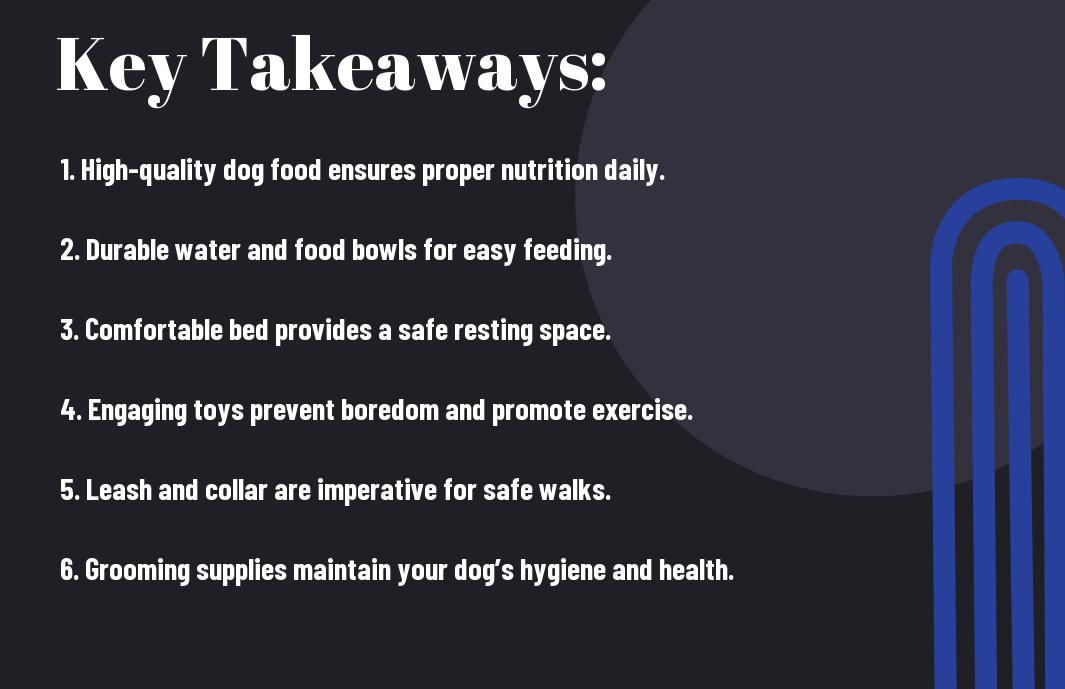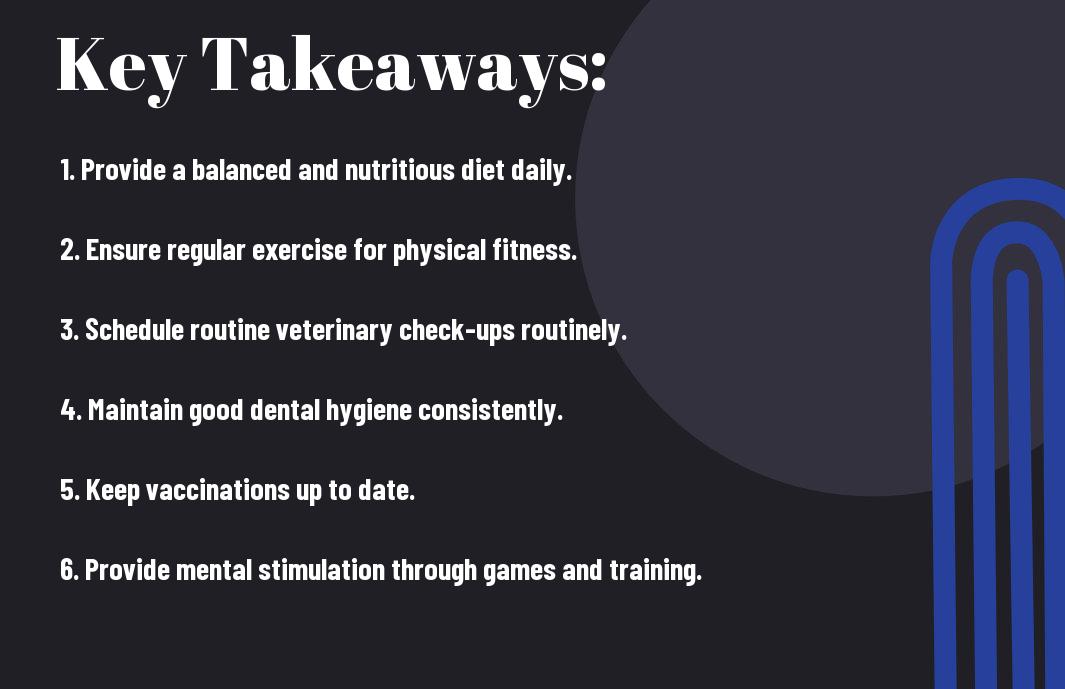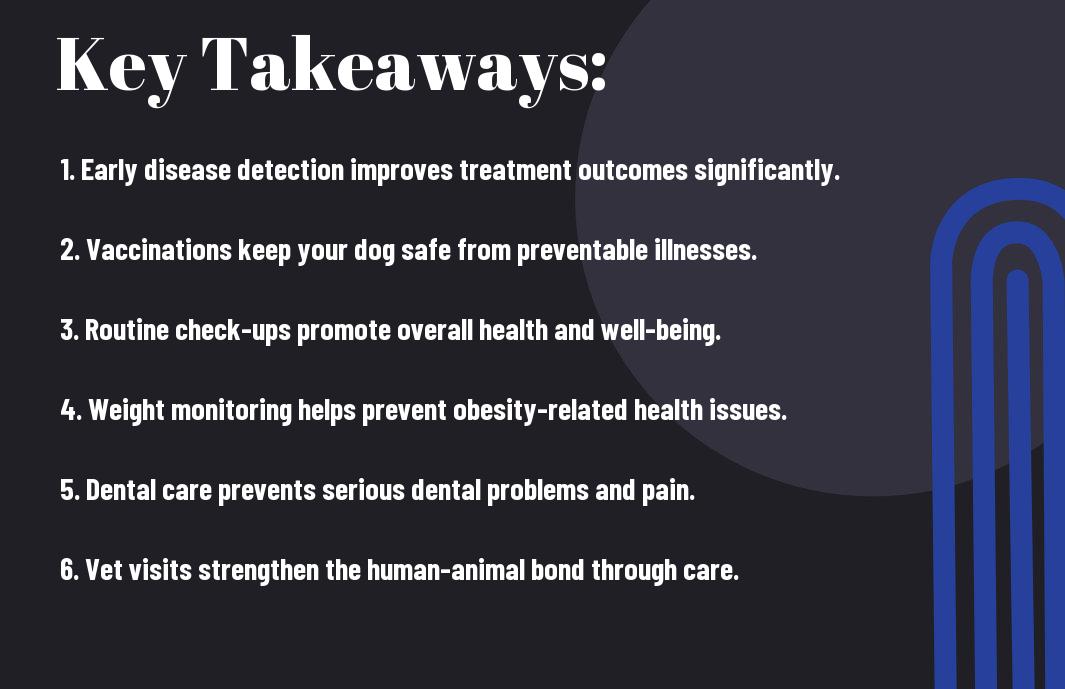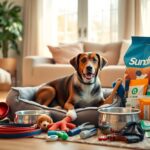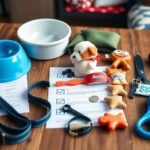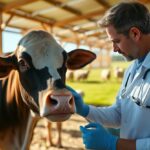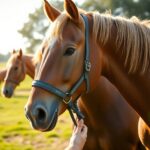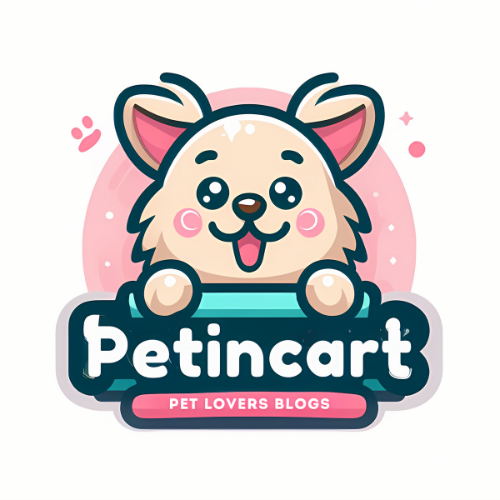There’s a lot to learn when it comes to caring for your furry friend, and even seasoned pet owners can slip up. In this list, you’ll discover ten common mistakes that you might be making in your dog care routine. By identifying and avoiding these pitfalls, you can ensure your pet receives the best possible care, leading to a healthier, happier life. Get ready to enhance your understanding and become a more responsible dog owner!
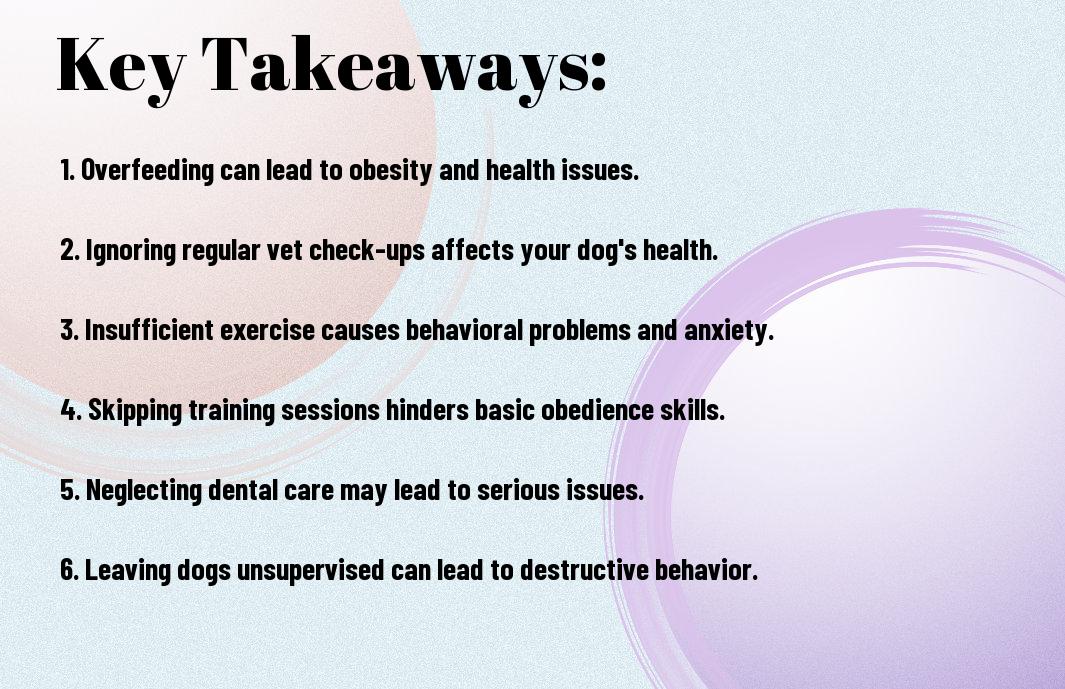
Ignoring Regular Vet Visits
While it might be tempting to skip a vet appointment if your dog seems healthy, regular veterinary visits are crucial for their long-term wellbeing. Many pet owners overlook this aspect of dog care, often believing that as long as their dog appears fit, there’s no need for a check-up. However, early detection of any potential health issues can have a significant impact on your dog’s health and life span. Neglecting these vital appointments can result in undiagnosed conditions that can escalate into serious problems.
Missing Vaccinations
The importance of keeping your dog’s vaccinations up to date cannot be overstated. Vaccines protect your pet from a range of serious ailments and diseases, many of which can be life-threatening. Whether it’s rabies, parvovirus, or distemper, ensuring your dog is vaccinated not only safeguards their health but also protects other animals and even humans. Failing to keep up with vaccinations can leave your dog vulnerable to infections that are otherwise preventable.
Preventive Health Checks
Missing regular preventive health checks can lead to missed issues, some of which may develop into more significant health challenges over time. These check-ups allow your veterinarian to assess your dog’s general health, monitor weight, evaluate dental health, and check for any changes that may indicate underlying conditions. Regular visits also provide you with the opportunity to discuss diet, behavior, and any concerns you might have about your dog’s health.
Health assessments during these check-ups help ensure your dog stays in optimal condition. By addressing small problems before they develop into major health issues, you can save both time and money while ensuring your furry friend lives a longer and healthier life. So don’t wait for visible signs of illness—schedule those appointments regularly and stay proactive in your dog’s health management.

Poor Diet Choices
One significant factor in ensuring the health and happiness of your dog is providing a proper diet. Making poor diet choices can lead to a variety of health issues for your furry friend, impacting everything from their energy levels to their longevity. Understanding the importance of your dog’s nutritional needs is important for their overall well-being and can help you make informed food selections.
Inappropriate Food Types
You’ll want to be mindful of the types of food you offer your dog. Not all foods are suitable for your canine companion, and some may even be harmful. Certain human foods can pose a serious risk to your dog, such as chocolate, grapes, and onions. Additionally, feeding your dog a diet that is primarily composed of low-quality fillers can lead to nutrient deficiencies over time. Here are some inappropriate food types to avoid:
| Food Type | Reason to Avoid |
| Chocolate | Toxic to dogs |
| Grapes and Raisins | Can cause kidney failure |
| Onions and Garlic | Can damage red blood cells |
| Xylitol (in sugar-free foods) | Can lead to insulin release and low blood sugar |
| Low-quality dog food | Poor nutritional value |
This list is not exhaustive, but it highlights some of the most hazardous food items to your dog. Always opt for high-quality dog food that meets the nutritional standards set by veterinary professionals.
Overfeeding or Underfeeding
For many pet owners, finding the right balance in their dog’s food intake can be challenging. Overfeeding may lead to obesity, which can cause a myriad of health issues such as diabetes, heart disease, and joint problems. On the other hand, underfeeding can result in malnutrition and a host of health complications, including lethargy and weakened immune function. Both cases can drastically affect your dog’s quality of life.
Food serving sizes should be tailored to your dog’s specific needs, which can vary depending on factors such as age, weight, breed, and activity level. Always consult with your veterinarian about the appropriate feeding guidelines for your dog. This personalized advice will empower you to help maintain a balanced diet that promotes long-term health.
Lack of Exercise
Many pet owners underestimate the importance of regular exercise in their dog’s daily routine. Just like humans, dogs need physical activity to maintain their physical health and mental well-being. A sedentary lifestyle can lead to obesity, behavioral issues, and a host of other health problems for your furry friend. Ensuring that your dog receives adequate exercise should be a priority in your dog care regimen.
Inadequate Daily Walks
Daily walks are crucial for your dog’s exercise routine. These walks not only provide the physical activity your dog needs, but also offer mental stimulation by exposing them to new sights, sounds, and smells. A lack of sufficient daily walks can result in pent-up energy, leading to destructive behaviors or increased anxiety. Aim to incorporate at least 30 minutes to an hour of walking into your dog’s daily routine, depending on their age, breed, and energy level.
No Playtime Activities
Little do many dog owners realize that playtime is just as important as walking when it comes to your dog’s exercise needs. Engaging your dog through play helps to strengthen the bond between the two of you while simultaneously providing mental and physical stimulation. Activities such as fetch, tug-of-war, or even agility exercises keep your dog active and motivated, reducing boredom that can lead to negative behaviors.
Playtime should not be overlooked in your dog care routine. Designing fun and interactive activities can enhance your dog’s happiness and overall health. Whether you have a large backyard or a small apartment, you can find ways to incorporate play into your dog’s day. Make it a point to allocate time specifically for play, ensuring that your dog has a well-rounded exercise regime that balances both structured walks and unstructured playtime.
Neglecting Grooming Needs
To ensure your dog remains healthy and happy, you must prioritize grooming as an necessary aspect of their care. Neglecting grooming can lead to various physical and emotional issues for your pet. This chapter will explore two common mistakes within this area: skipping baths and unmanaged coat issues.
Skipping Baths
Now, bathing your dog is not just about keeping them clean; it is also about maintaining their skin health. Regular baths help remove dirt, debris, and parasites, while also preventing skin infections and irritations. If you skip baths, you may find that your dog develops an unpleasant odor and may even scratch or bite at their skin in discomfort. Consistent bathing, based on your dog’s breed and lifestyle, is vital for their overall well-being.
In addition to preventing health issues, skipping baths can also affect your dog’s mood and behavior. A clean, well-groomed dog is typically more relaxed and comfortable. When you prioritize your dog’s bathing routine, you contribute to their happiness, and a few additional minutes of your time can foster a stronger bond between the two of you.
Unmanaged Coat Issues
Clearly, failing to address coat issues can lead to significant distress for your dog. Different breeds have different grooming needs, and neglecting these specific requirements can result in mats, tangles, or excessive shedding. If you notice your dog has a matted coat, it is necessary to take action promptly. Allowing these issues to remain unmanaged can not only lead to physical discomfort for your pet but also contribute to skin issues and infections in the long run.
This situation can also cause your dog to become anxious or withdrawn, impacting their overall quality of life. Regular brushing and professional grooming when necessary will help maintain a healthy coat and minimize the occurrence of any issues. By staying attentive to your dog’s grooming needs, you greatly enhance their comfort and happiness, giving them a better quality of life.

Inconsistent Training Routines
Not adhering to a consistent training routine can significantly hinder your dog’s learning and behavior. When you fail to provide routine, you might confuse your pet, leading to frustration for both you and your furry companion. To foster a healthy relationship and promote good behavior, establishing a consistent environment is key.
Mixed Commands
An inconsistent training routine often involves using mixed commands, where you may inadvertently teach your dog different cues for the same action. For instance, using phrases like “sit,” “sit down,” or “get down” interchangeably might leave your dog puzzled about what you actually expect. Instead, it is crucial to choose singular, clear commands and consistently use them so your dog can develop a solid understanding of what each command means.
Lack of Discipline
If you do not maintain consistent discipline for your dog’s behavior, they may not take your commands seriously. Inconsistent reactions can lead to behavioral problems, as your dog learns that sometimes bad behavior is tolerated while at other times it is not. Establishing clear boundaries and sticking to them is crucial for your dog to understand what is acceptable and what is not.
With a lack of discipline, you crucially create an unstable learning environment for your dog. This instability can lead to confusion, anxiety, and unwanted behaviors. By being consistent in how you enforce rules and remain firm during training sessions, you will cultivate a more well-behaved dog and a smoother training experience for both of you.
Inadequate Socialization
All dogs require proper socialization to develop into well-adjusted companions. If your dog is not exposed to various people, environments, and experiences, they may become anxious or aggressive in unfamiliar situations. Socializing your dog helps them learn to interact with others appropriately and builds their confidence. When considering your dog’s social needs, it is necessary to provide a variety of experiences during their formative months and continue that exposure throughout their lives.
Isolation from Others
To ensure your dog thrives, you must avoid isolating them from other animals and humans. Keeping your dog confined to your home or backyard limits their ability to develop social skills. This isolation can lead to behavioral issues as your dog may find it difficult to interact positively with others when they eventually encounter them. Frequent playdates with other dogs or visits to dog parks can help your pup learn appropriate play behaviors and how to read other dogs’ body language.
Fear of New Experiences
Isolation from different settings and experiences can lead to a fear of new situations or environments. When dogs are not exposed to various stimuli during their critical developmental periods, they may react with anxiety or aggression when they encounter something unfamiliar. To help mitigate this, actively introduce your dog to new sights, sounds, and smells in a controlled manner that allows them to explore without being overwhelmed.
With time and positive reinforcement, you can help your dog gain confidence in new experiences. Always aim to create a positive association with unfamiliar situations by rewarding your dog with treats or praise when they approach something new. This encourages them to embrace new experiences rather than view them as threats, facilitating an overall more relaxed and adaptable demeanor when facing the world.
Overlooking Dental Care
After bringing a dog into your home, it’s easy to focus on their immediate needs like food, exercise, and grooming, but one aspect you might overlook is their dental health. Just like humans, dogs can suffer from dental issues that can lead to serious health problems if not addressed properly. Maintaining your dog’s oral hygiene is necessary for its overall health and wellbeing, and neglecting this important aspect of care can lead to painful conditions and costly treatments down the line.
Ignoring Tooth Brushing
You might think that brushing your dog’s teeth is unnecessary, but this simple practice can significantly reduce the risk of plaque buildup and periodontal disease. Ideally, you should start brushing your dog’s teeth early in their life to help them get accustomed to the routine. Using a toothbrush specifically designed for dogs, along with toothpaste that is safe for them, will make the process easier and more effective. Even if your dog resists at first, regularly introducing this practice can help them understand that it’s a part of their daily care.
Additionally, incorporating dental chews or dental diets can complement your tooth brushing efforts, but these should not replace regular brushing. It’s important to be proactive about your dog’s dental health to prevent long-term problems. Consider setting a schedule for brushing, aiming for at least a few times a week to keep your dog’s teeth and gums in good condition.
No Professional Cleanings
Tooth health also requires professional attention, as you may not be able to reach every area of your dog’s mouth with regular brushing. Neglecting professional cleanings means that tartar can build up, leading to more serious health issues like infections or even organ damage over time. Regular veterinary check-ups should include an assessment of your dog’s dental health, and depending on your dog’s needs, the vet may recommend professional cleanings.
Dental cleanings can help remove plaque and tartar that regular brushing can’t eliminate, ensuring your dog’s mouth remains healthy. Most vets recommend scheduling these cleanings at least once a year; however, some dogs may need them more frequently depending on their breed, age, and overall dental condition. Taking this step is not just about their teeth; it helps maintain their quality of life and longevity.
Not Providing a Safe Space
Unlike a human, your dog is highly reliant on their environment to feel safe and secure. Creating an environment that prioritizes safety is necessary for their well-being and happiness. A safe space can help prevent accidents and injuries while providing your dog with a place to retreat when they’re feeling stressed or anxious. When you overlook the need for a safe environment, you could inadvertently put your furry friend at risk, making it important to assess your home and yard for hazards regularly.
Unsafe Environment
An unsafe environment can manifest in many ways, whether it’s toxic plants in your home, unsecured trash that they can rummage through, or exposing them to hazardous materials like cleaning supplies. Sharp edges, exposed electrical cords, and choke hazards are just a few examples of things you should address as a responsible dog owner. Ensure that your home is dog-proofed—from securing furniture they could topple over to eliminating escape routes in your yard, safeguarding your pet’s environment is non-negotiable.
Lack of Personal Area
There’s no denying that dogs thrive in personal space that’s exclusively theirs. A designated spot, such as a bed, crate, or blanket, can provide your dog with a sense of ownership and comfort. Without this personal area, they may feel insecure or anxious, leading to behavioral issues. It’s important to establish a cozy place where your dog can retreat, especially during chaotic times or when they need a moment to relax.
You can enhance your dog’s personal area by adding familiar items, such as their favorite toys or blankets, to make it feel more inviting. Ensure that this space is away from high-traffic areas and noise, providing a quiet refuge where they can decompress. By valuing their need for personal space, you can significantly improve their emotional health and overall behavior.
Failing to Identify Health Issues
Despite the joy and companionship your dog brings, overlooking potential health issues can lead to serious consequences for their well-being. Dogs can be exceptionally good at hiding their pain and discomfort, making it important for you to be proactive in identifying any subtle signs indicating changes in their health. Regular vet check-ups and a good understanding of your dog’s normal behavior can help you catch issues before they become severe.
Ignoring Behavioral Changes
On many occasions, changes in your dog’s behavior can signal underlying health problems. If you notice your pet becoming more withdrawn, excessively lethargic, or displaying unusual aggression, these changes should be taken seriously. Sometimes, such behaviors may stem from physical pain or emotional distress linked to health issues that need timely attention. Engaging with your dog and observing their day-to-day activities helps create a baseline for what’s normal, allowing you to better identify when something is off.
Not Observing Symptoms
Failing to observe symptoms in your dog could lead to missing critical early signs of illness. Keep an eye on their eating habits, bathroom habits, and overall energy levels. Sudden changes in appetite, increased thirst, or housebreaking accidents can be red flags that suggest a medical issue. Don’t underestimate the importance of monitoring these symptoms; they often provide valuable insights into your dog’s health and can help your veterinarian make an accurate diagnosis.
This is why it’s important to track not just the obvious physical symptoms but also any behavioral nuances. Keeping a log of your dog’s habits and behaviors can aid both you and your vet in identifying patterns or changes that warrant further investigation. The more informed you are about your dog’s normal routine, the better equipped you will be to recognize when something is amiss with their health.
Giving Human Food
For many dog owners, it’s tempting to share a bite of their meal with their furry friends. While it might seem harmless, giving human food to your dog can lead to various health issues and should be approached with caution. Dogs have different dietary needs compared to humans, and not all foods safe for us are safe for them. By understanding what foods can be harmful, you can better protect your beloved pet’s health.
Toxic Food Items
With a wide variety of foods available, it is important to know which ones are toxic to dogs. Common items such as chocolate, grapes, raisins, onions, and garlic can lead to serious health problems, including organ failure and even death. Always avoid these foods and be cautious with any leftovers or treats you might be tempted to share. Educating yourself about harmful substances can help you make safer choices for your dog’s diet.
Unbalanced Nutrition
Clearly, offering your dog human food regularly can lead to an unbalanced diet, which might not meet their nutritional needs. Dogs require a specific balance of proteins, fats, carbohydrates, vitamins, and minerals to thrive. While it might be enjoyable to share what you’re eating, doing so can disrupt this delicate nutritional balance, potentially resulting in weight gain, digestive problems, or nutrient deficiencies.
Giving your dog an occasional treat from your plate may seem harmless, but it is vital to evaluate the nutritional content of what you are sharing. Instead of relying on human food, consider providing dog-safe options that are specifically formulated to meet their dietary needs. By prioritizing your dog’s health, you ensure that they remain vibrant and active, ultimately leading to a happier life for both of you.
Summing up
Hence, as a responsible dog owner, it’s necessary to be mindful of these common mistakes to ensure the well-being and happiness of your furry companion. Avoiding pitfalls such as inadequate nutrition, neglecting training, and failing to provide regular veterinary care can significantly improve your dog’s quality of life. By being attentive to their needs and habits, you foster a healthy and loving environment that strengthens the bond between you and your pet.
Additionally, staying informed about your dog’s specific breed requirements and behavioral tendencies can further enhance your caregiving skills. Taking the time to educate yourself about their physical and emotional needs not only contributes to their development but also ensures that your relationship remains positive and enriching. Ultimately, your dedication to avoiding these common mistakes will lead to a happier and healthier life for both you and your dog.
FAQ
Q: What are some common mistakes dog owners make regarding diet and nutrition?
A: One frequent mistake is choosing low-quality dog food, which may contain fillers instead of nutritious ingredients. It’s important to select a diet that meets your dog’s specific needs based on age, size, and health condition. Additionally, overfeeding or underfeeding can lead to health issues. Always consult with a veterinarian for tailored dietary recommendations, and avoid giving table scraps or human food that can be harmful to dogs.
Q: How can neglecting regular vet visits affect my dog’s health?
A: Skipping regular veterinary check-ups can lead to undiagnosed health problems that may escalate into serious conditions. Many illnesses can be prevented with vaccinations and routine screenings. Regular visits also provide an opportunity for your vet to address any behavioral concerns and offer guidance on age-appropriate protocols for care. Staying on top of preventive care is key to ensuring your dog lives a healthy and happy life.
Q: What are the implications of inadequate socialization for my dog?
A: Insufficient socialization can result in fearfulness, aggression, or anxiety in dogs when confronted with new people, environments, or other animals. It’s important to expose your dog to various situations in a positive manner during their early months. This experience helps develop confidence and adaptability, reducing the likelihood of behavioral issues later. Engaging in training classes or social outings can provide safe opportunities for your dog to interact and learn.
